Chandrashila Summit Trek – Uttarakhand’s Hidden Skywalk
Published on July 14, 2025
Chandrashila Summit Trek in Uttarakhand is a truly amazing journey. Imagine a path that goes way up high, like a skywalk, but made by nature. You'll walk through old forests, climbing higher and higher until it feels like you can touch the clouds. This isn't just some walk in the park; it's an adventure where the cool mountain air fills your lungs and you see incredible views all around. From Tungnath, which is the highest Shiva temple in the world, to the top of Chandrashila peak where you can see everything, every part of this trail is just beautiful and peaceful. It’s a trek that gives you not only stunning sights but also a real connection with the huge Himalayas.
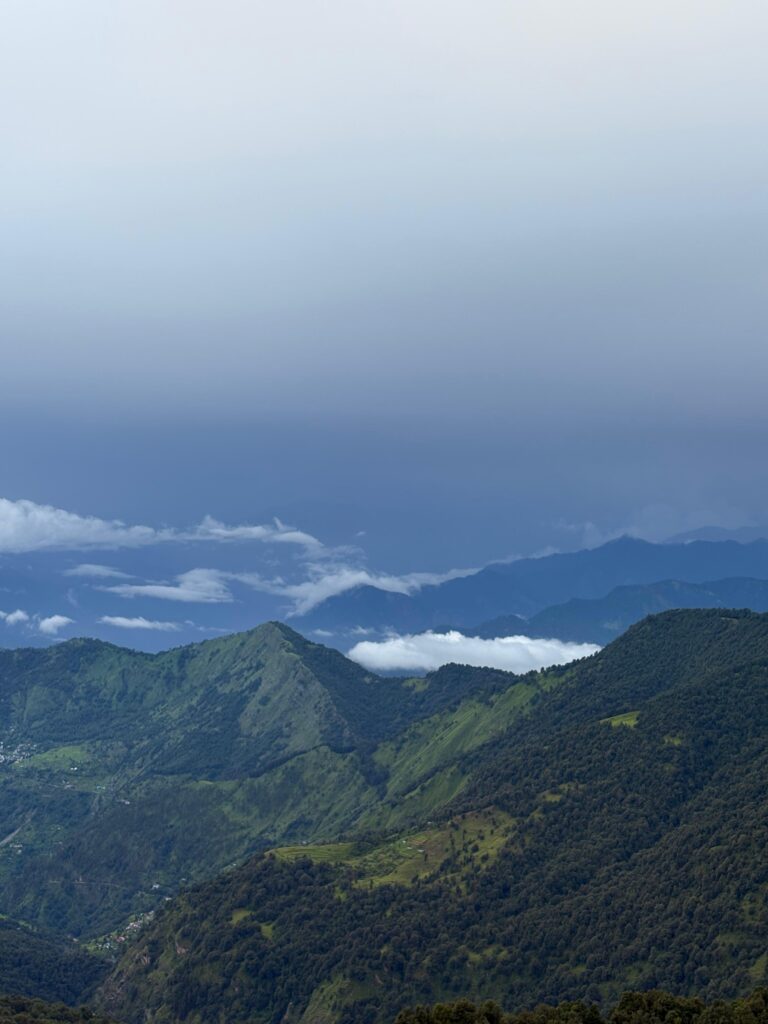
Ideal Itinerary for Chandrashila Trek (2 to 3 Days Plan)
Day 0: Delhi to Rishikesh to Sari Village
- Departure: Start your journey from Botanical Garden Metro Station at 10:00 PM.
- Overnight Journey: Travel overnight towards Sari Village via Rishikesh.
- Stop at Devprayag: Witness the mesmerizing confluence of the Bhagirathi and Alaknanda rivers along the way.
Day 1: Sari Village to Deoriatal
- Arrival at Sari Village: Check into your homestay and take some time to freshen up.
- Trek to Deoriatal: Begin your trek to Deoriatal (2.5 km, approximately 1.5–2 hours).
- Enjoy Deoriatal: Soak in the serene beauty of the lake and the surrounding landscapes.
- Return to Sari Village: Head back to Sari Village and enjoy a peaceful evening.
Day 2: Sari Village to Tungnath & Chandrashila
- Breakfast: Start your day with a hearty breakfast at your homestay.
- Drive to Chopta: A scenic drive of about 1 hour from Sari Village.
- Trek to Tungnath Temple: Embark on a 3.5 km trek to the sacred Tungnath Temple.
- Summit Chandrashila: Extend your trek by 1.5 km to reach the breathtaking Chandrashila summit.
- Return to Chopta/Sari: After the trek, return to Chopta or Sari for an overnight stay at the campsite.
Day 3: Chopta to Delhi
- Breakfast: Enjoy an early breakfast at your campsite in Chopta.
- Departure: Begin your journey back to Delhi in the early morning.
- Visit Dhari Devi Temple: Stop by the revered Dhari Devi Temple en route.
- Arrival in Delhi: A long drive of approximately 10–12 hours marks the end of your adventure.
Inclusion
-
One Night Accommodation In Sari Village.
-
One Night Accommodation In Chopta/Sari Village.
-
4 Meals Will Be Provided Throughtout The Trip.
-
AC Transportation.
-
Guide While trekking.
-
Experienced Trip Captain Throught The Trip.
Exclusion
-
5% GST
-
Extra Drinks, Food, Tea and Snacks.
-
Tickets for any sightseeing or extra activity outside the camp area.
-
Travel Insurance and other benefits.
-
Anything which is not mentioned in inclusions.
-
Cost escalation due to any unforeseen reason like weather, road condition landslide etc.
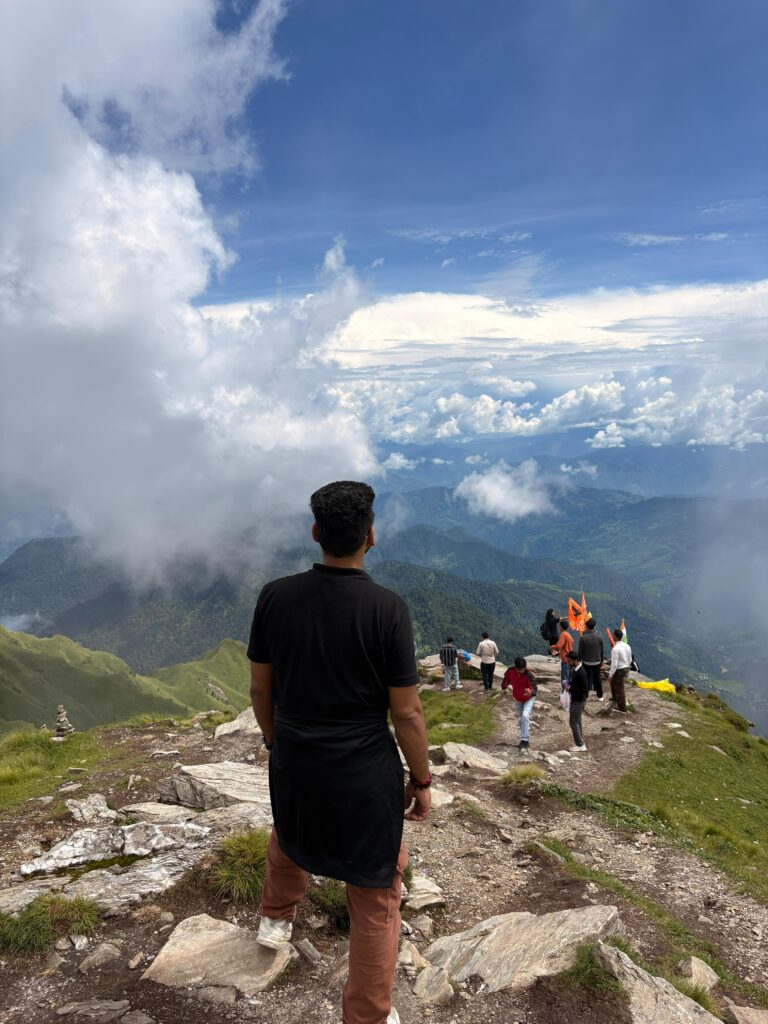
What Makes the Chandrashila Summit Trek So Special?
The Chandrashila Summit Trek holds a truly special place in the hearts of those who venture into the Himalayas. It’s not just about reaching a peak; it’s a whole experience, blending stunning nature with a deep sense of peace. From the moment you begin your journey, often from the charming village of Chopta, you feel a different kind of calm settle over you. This trek is famous for how it packs so much wonder into a relatively short and manageable path, making it perfect for both first-timers and seasoned trekkers.
What really makes the Chopta Chandrashila Trek stand out?
-
The Highest Shiva Temple: The trek takes you right past the ancient Tungnath Temple, which is the highest Shiva temple in the whole world. Standing there, surrounded by towering peaks, you feel a strong spiritual vibe. It’s a place that has seen centuries of devotion, and that history hangs in the air. Many people visit not just for the trek, but for this sacred connection.
-
Mind-blowing Views: When you finally reach the Chandrashila summit, it’s like the world opens up. You get an unbelievable 360-degree view of huge Himalayan peaks. Imagine seeing Nanda Devi, Trishul, Chaukhamba, and Kedar Peak all at once! On a clear day, especially at sunrise, the way the light hits those snow-capped giants is something you’ll never forget. It's a view that truly makes you feel on top of the world.
-
Nature's Masterpiece: The trail itself is a treat. You walk through dense, ancient forests filled with oak and rhododendron trees. In spring, these rhododendrons burst into vibrant reds and pinks, turning the path into a colorful dream. You might even spot some unique Himalayan birds, like the colorful Monal. The changing scenery, from lush meadows to rugged, rocky stretches, keeps every step interesting.
-
Accessible Adventure: Despite offering such grand views and spiritual depth, the Chandrashila Trek is considered easy to moderate. This means more people can enjoy the magic of the high Himalayas without needing extreme fitness levels. It’s a rewarding challenge that leaves you feeling accomplished, but not completely worn out.
-
Peace and Quiet: Unlike some other crowded spots, the Chopta Chandrashila Trek often feels wonderfully peaceful. You get moments of solitude to truly soak in the clean mountain air and the quiet majesty of nature. It’s a chance to disconnect from the busy world and reconnect with yourself.
Ultimately, the Chandrashila Summit Trek is special because it offers a perfect mix: an exciting physical journey, a deeply spiritual experience, and an immersion in some of the most beautiful natural landscapes the Indian Himalayas have to offer. It’s a trip that stays with you, long after you’ve left the mountains behind.
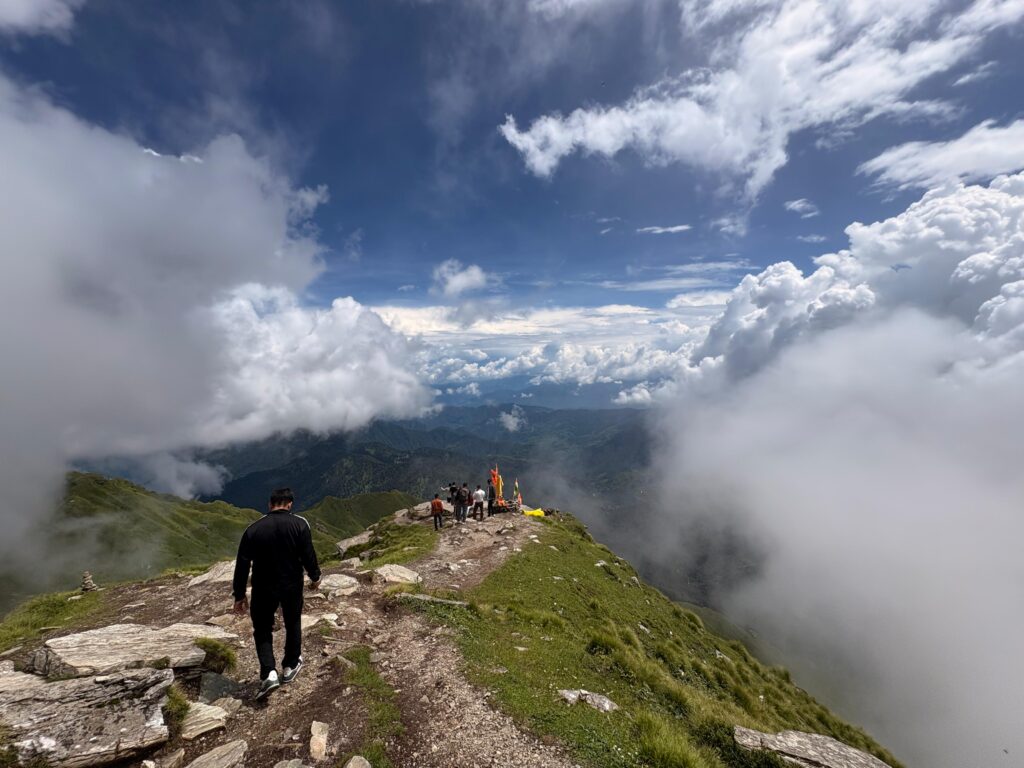
Where is Chandrashila? Geography & Spiritual Significance
Chandrashila, which translates to "Moon Rock," is a majestic summit nestled high in the Garhwal Himalayas of Uttarakhand, India. It sits at an impressive altitude, often cited around 3,690 to 4,000 meters (12,110 to 13,000 feet) above sea level, making it a significant peak in the region. This elevated position provides a spectacular vantage point, offering unparalleled 360-degree panoramic views of some of the most iconic Himalayan giants, including Nanda Devi, Trishul, Chaukhamba, Kedar Peak, and Bandarpunch. The trek to this summit typically begins from Chopta, a beautiful meadow area that acts as a base camp.
The spiritual significance of Chandrashila runs deep, woven into the fabric of Hindu mythology and ancient legends:
- Lord Rama's Meditation: One of the most prominent legends connects Chandrashila to Lord Rama, the central figure of the epic Ramayana. It's believed that after his victory over the demon king Ravana, Lord Rama meditated at this very peak to seek penance for his actions and find inner peace. This association imbues the summit with a profound sense of sanctity and draws pilgrims seeking spiritual solace.
- Moon God's Penance: Another legend states that Chandra, the Moon God, spent time in penance here to be relieved from a curse. This tale is believed to be the origin of the peak's name, "Chandrashila," meaning "Moon Rock."
-
Connection to Tungnath Temple: Chandrashila is also intrinsically linked to the revered Tungnath Temple, which is situated just below the summit. Tungnath is the highest Shiva temple in the world and is one of the Panch Kedar temples, a group of five sacred shrines dedicated to Lord Shiva. Pilgrims consider the trek to Tungnath, and then the further ascent to Chandrashila, a spiritual pilgrimage. It's said that Lord Shiva's arms appeared at Tungnath according to the Mahabharata legend, where the Pandavas sought to atone for their sins after the Kurukshetra war. This close proximity to such a significant Shiva temple further enhances Chandrashila's spiritual aura, making it a destination where natural grandeur and divine presence powerfully converge.

The Tungnath Temple Trek – Path to the World’s Highest Shiva Shrine
The Tungnath Temple Trek isn't just a walk; it's a profound pilgrimage to the world's highest Shiva shrine, high in the Rudraprayag district of Uttarakhand. This journey offers a unique blend of spiritual solace and breathtaking Himalayan views, making it a favorite for both devout pilgrims and trekking enthusiasts.
History & Spiritual Value of Tungnath Temple
The Tungnath Temple, standing at an astounding altitude of approximately 3,680 meters (12,073 feet) above sea level, is believed to be over a thousand years old. It holds a paramount position among the Panch Kedar temples, a group of five sacred Shiva shrines in the Garhwal Himalayas. Each temple connects to a specific part of Lord Shiva's body, which, as legend tells, appeared here after he tried to avoid the Pandavas.
The most widely accepted legend states that after the epic Kurukshetra War, the Pandavas sought to atone for their sins of killing kin. Lord Shiva, displeased, disguised himself as a bull to evade them. However, Bhima, one of the Pandavas, recognized him. As Shiva dove into the ground, different parts of his body emerged at various spots. At Tungnath, his arms (bahu) are believed to have reappeared, giving it the name 'Tungnath' meaning 'Lord of the Arms.' The Pandavas then built the temple here to worship Lord Shiva and seek blessings. This deep mythological link fills the temple with immense spiritual power, drawing countless devotees who brave the heights to offer prayers and experience its divine presence.
The temple's architecture is simple yet strong, built with stones and showing traditional North Indian style. Despite its remote, high location, the temple stands as a testament to ancient craftsmanship and unwavering faith. Smaller shrines dedicated to other deities surround the main shrine, adding to its sacred complex.
The Chopta Tungnath Trek Route
The Tungnath Temple Trek is known for being relatively easy to moderate, especially considering it leads to the world's highest Shiva temple. This accessibility makes it a popular choice for many trekkers.
The main and most common start point for the tungnath temple trek is the beautiful village of Chopta, often called the "Mini Switzerland of India" for its green meadows and wide views.
-
Starting Point: The actual trek to Tungnath begins from Chopta, which has good road connections from major Uttarakhand towns like Rishikesh, Haridwar, Rudraprayag, and Ukhimath.
-
Trek Distance and Duration: From Chopta, the trek to Tungnath Temple is about 3.5 to 4 kilometers one way. It usually takes 2 to 3 hours to reach the temple, depending on your pace and fitness.
-
The Trail: The path is clear, mostly a stone-paved trail that goes through thick oak and rhododendron forests. In spring (April-May), the rhododendron bushes bloom in bright reds and pinks, making the walk very scenic. The trail has steady, gradual climbs with a few steeper parts, but it's generally manageable.
-
Views Along the Way: As you go up, you'll constantly see amazing views of the grand Himalayan peaks, like Chaukhamba, Nanda Devi, Trishul, and Kedar Peak, which get wider and more impressive. The clean mountain air and calm surroundings add to the journey's spiritual and natural charm.
-
Continuing to Chandrashila: If you want an even bigger experience, you can extend the trek by another 1.5 kilometers (about 1 hour) from Tungnath Temple to the Chandrashila Summit. This offers unmatched 360-degree panoramic views, especially at sunrise.
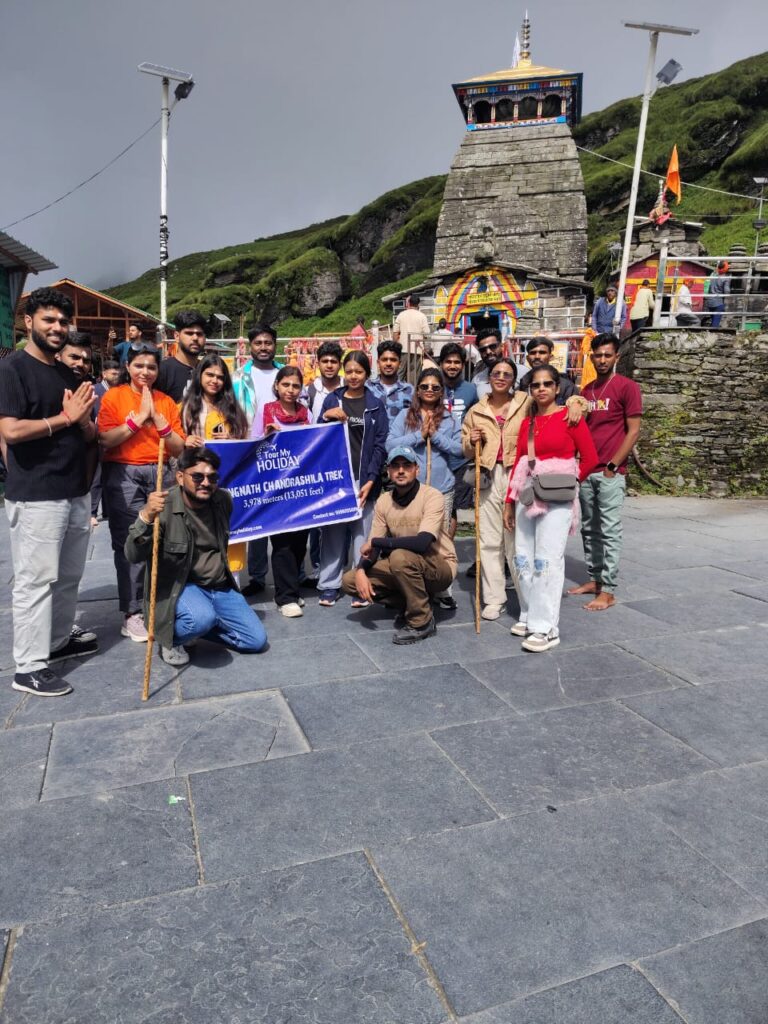
Chandrashila Trek Route – Distance, Difficulty & Duration
The Chandrashila Trek offers one of the most rewarding and accessible high-altitude experiences in the Indian Himalayas. It's a journey that culminates in truly spectacular panoramic views, making every step worthwhile.
The Trek Trail Breakdown: Chopta to Chandrashila
The primary route for the Chandrashila Trek begins from the charming mini-town of Chopta, often called the "Mini Switzerland of India" due to its stunning meadows.
-
Starting Point: Chopta
-
Altitude of Chopta: Approximately 2,680 meters (8,790 feet).
-
Chopta serves as the base for this trek. It's easily reachable by road from major hubs like Rishikesh, Haridwar, and Rudraprayag.
-
The trail from Chopta is well-marked and relatively clear, making it a favorite for various levels of trekkers.
-
-
Segment 1: Chopta to Tungnath Temple
-
Distance: Approximately 3.5 to 4 kilometers (2.2 to 2.5 miles) one way.
-
Difficulty: Easy to Moderate. The path is mostly stone-paved, with a consistent uphill gradient. It's a gradual climb for much of the way.
-
Duration: Typically 2 to 3 hours, depending on individual fitness and the number of stops for photos or rest.
-
The Trail: This section winds through dense, beautiful forests of oak and rhododendron. In spring (April-May), these forests burst into vibrant colors from the blooming rhododendrons, creating a truly picturesque walk. You might spot Himalayan Monal pheasants or other birds along the way.
-
Tungnath Temple: At the end of this segment lies the ancient Tungnath Temple, the highest Shiva temple in the world, standing at around 3,680 meters (12,073 feet). This sacred stop offers spiritual solace and a chance to take in the views before the final push.
-
-
Segment 2: Tungnath Temple to Chandrashila Summit
-
Distance: Approximately 1.5 kilometers (just under 1 mile) one way.
-
Difficulty: Moderate. This section is steeper and more challenging than the first, with a rockier path.
-
Duration: About 1 hour, depending on conditions (especially snow) and individual pace.
-
The Ascent: The trail leaves the main temple complex and climbs steadily towards the open summit. As you gain height, the tree line recedes, and the views become increasingly expansive.
-
Chandrashila Summit: This is the highest point of the trek, reaching an altitude of approximately 3,690 to 4,000 meters (12,110 to 13,000 feet). The summit offers unparalleled 360-degree panoramic views of major Himalayan peaks like Nanda Devi, Trishul, Chaukhamba, Kedar Peak, and Bandarpunch. Sunrise from here is particularly famous, painting the snow-capped peaks in golden hues.
-
-
Return Journey: The descent back to Chopta follows the same route and typically takes less time, around 3 to 4 hours in total from the summit back to Chopta.
Overall Chandrashila Trek Details:
-
Total Trek Distance (Round Trip from Chopta): Approximately 10-11 kilometers (6.2-6.8 miles).
-
Overall Difficulty: Easy to Moderate. While the Tungnath section is relatively easy, the final push to Chandrashila is steeper. During winter (December to March), the difficulty increases significantly due to heavy snow, requiring gaiters, microspikes, and good winter trekking experience.
-
Total Trek Duration (from Chopta, including stops): Typically 5 to 7 hours for the round trip.
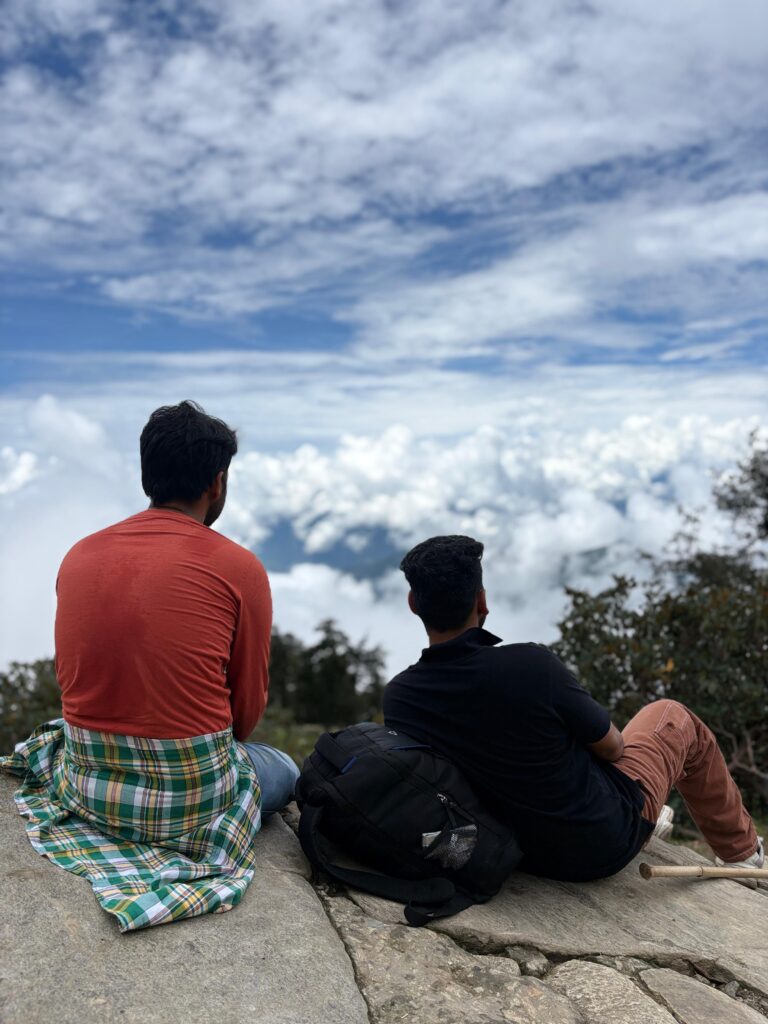
Sunrise from Chandrashila – Why It's Called the Skywalk
The Chandrashila Summit Trek is often called a "Skywalk" for a very good reason: the amazing 360-degree views you get from its top, especially when the sun comes up. Getting to this peak, usually after an early morning climb from Tungnath Temple, feels like you're standing on top of the world. All around you, there's just a long line of huge Himalayan mountains.
Seeing the Sun Rise from Chandrashila
Imagine being almost 4,000 meters (13,000 feet) up, as the first light of morning breaks through the dark. The cold air you felt earlier quickly goes away as the sky starts to change in a big way. Deep blue colors turn into soft purple, then bright orange, fiery red, and finally, a shining gold. This light isn't just in the sky; it spreads across the huge, snow-covered mountains, coloring them in ways that seem to change and glow every second.
-
Nanda Devi: This giant mountain, the second highest in India, often gets the first golden light of the sun. Its huge size and clean white slopes light up, showing how powerful and beautiful the Himalayas are. Seeing Nanda Devi from Chandrashila is like watching a painting come alive.
-
Trishul: Named after Lord Shiva's three-pronged spear, Trishul is another big mountain that really stands out. Its three clear peaks get sharp outlines against the brightening sky, often glowing a bit pink as the sun gets higher. Looking at Trishul from Chandrashila is very cool because of its special shape.
-
Kedarnath (and Kedarnath Dome/Peak): While the Kedarnath temple is further off, the massive Kedarnath Peak and its nearby Dome are easy to see from Chandrashila. These giants of the Garhwal Himalayas stand tall, often looking like huge, snow-covered forts. Having these important, holy peaks in view adds a deep spiritual feeling to what you're seeing.
-
Chaukhamba: This means "four pillars" in Hindi. Chaukhamba is a group of four big peaks that takes up a lot of the view to the east from Chandrashila. Its big, grand shape is truly amazing to see as the morning light covers its huge snow fields.
-
Other Big Mountains: Besides these really big ones, you can also see other important mountain ranges like Bandarpunch and the Gangotri peaks, stretching out forever. The air can be so clear that the vastness of the mountains feels amazing.
Why "Skywalk"?
The name "Skywalk" fits how it feels at Chandrashila because:
-
Views All Around (360 Degrees): Unlike many other viewpoints that only show you a bit, Chandrashila's top gives you a full circle of mountain views. Nothing blocks your sight, so it feels like you are walking right among the clouds with mountains all around.
-
Feeling High Up: At almost 4,000 meters, you are much higher than the valleys below and even many smaller mountains. This makes you feel like you are floating in the sky, looking down at a world made of mountains.
-
The Horizon Looks Close: The mountains far away seem surprisingly close, almost like you could step from one to the next. This makes it feel even more like a path among them.
-
Magical Feeling: The amazing way the sun rises, with the light, shadows, and often clouds below you, makes the whole experience feel almost unreal, like walking on air.
For anyone doing the chandrashila trek from delhi or the tungnath chandrashila trek from delhi, the early morning effort to reach this top is always the best part. It's a moment where what people do meets nature's greatness, giving you a sight and feeling that truly earns the name "Skywalk."

Best Time to Do the Chandrashila Trek – Weather by Season
Planning the Chandrashila Trek means picking the right time of year. Each season paints the landscape differently, offering unique experiences. Knowing what to expect month by month helps you choose the perfect Chopta tour package for your adventure.
Spring (March to May): Blooming Wonderland & Clear Skies
Spring is a fantastic time for the Chandrashila Trek. The weather is just right, and nature is coming alive.
-
March: Snow begins to melt, revealing green patches. The air is crisp, and it's less crowded. You'll still find some snow on the higher parts, especially closer to the summit. Day temperatures range from 5°C to 12°C.
-
April: This is when the famous rhododendron flowers burst into full bloom, covering the forests in shades of red and pink. The trail looks vibrant, and the pleasant weather makes for comfortable trekking. Clear skies usually offer great mountain views. Temperatures are typically between 7°C and 14°C.
-
May: The snow has mostly melted, and the meadows around Chopta and Tungnath turn a lush green. Days are sunny and warm (10°C to 20°C), making it ideal for walking. The views of the Himalayas are often very clear. This is a very popular time, so you might find more people on the trail.
If you're looking for a Chopta tour package from Delhi during spring, expect comfortable conditions and stunning natural beauty.
Monsoon (June to August): Green Paradise, Mist & Challenges
The monsoon season brings a different kind of beauty, but also added challenges.
-
June: Marks the start of the monsoon. You'll see occasional rain, and the landscape turns incredibly green and fresh. Visibility can be hit or miss; sometimes thick fog covers the mountains, creating a mystical feel, other times it clears for dramatic views.
-
July & August: These are the peak monsoon months. Heavy rainfall can make trails muddy and slippery, and there's a higher risk of landslides, especially on the roads leading to Chopta. Leeches can also be present. While the greenery is amazing, clear mountain views are rare due to clouds and fog. Temperatures are mild (8°C to 16°C).
Unless you're an experienced trekker who loves the rain and understands the risks, most chopta tour packages do not recommend trekking during these months.
Autumn (September to November): Crisp Air & Best Views
Autumn is widely considered one of the best times for the tungnath chandrashila trek from delhi due to its stable weather and incredible visibility.
-
September: After the monsoons, the air becomes crystal clear, and the skies are often cloudless. The trails are dry and clean. The views of the Himalayan peaks are simply breathtaking, sharp and defined. Temperatures are pleasant (10°C to 18°C).
-
October: Continues with excellent weather conditions. Days are cooler, and nights can get chilly. The forests begin to show hints of autumn colors, adding to the beauty. This is a prime month for photography. Temperatures typically range from 5°C to 15°C.
-
November: The chill in the air increases, and you might start to see early snowfall on the very highest peaks. The views remain fantastic, but you'll need warmer clothes. This month offers a quieter experience before the heavy winter snows. Temperatures often drop to 0°C at night at higher altitudes.
A chopta tour package in autumn is perfect for those seeking clear views and comfortable trekking.
Winter (December to February): Snowy Wonderland & True Adventure
Winter transforms the Chandrashila area into a pristine, snow-covered landscape, offering a challenging but truly magical experience.
-
December: Snowfall begins, covering the higher reaches, including Tungnath and Chandrashila. The trek becomes a snow trek, requiring appropriate gear like gaiters and microspikes. Roads to Chopta can sometimes be blocked by snow.
-
January & February: These are the coldest months with heavy snowfall. The entire region, including Chopta, is blanketed in deep snow. Temperatures can drop significantly below freezing (-5°C to -15°C or even colder at night). The Tungnath temple generally remains closed during these months due to snow. This period is for experienced winter trekkers and those seeking solitude and dramatic snowscapes.
While a chopta tour package from Delhi offering a winter trek can be an incredible adventure, it demands proper planning, cold-weather gear, and awareness of the increased difficulty and risks.
In summary, for most trekkers, Spring (April-May) and Autumn (September-October) provide the ideal balance of pleasant weather, clear views, and manageable trail conditions.

How to Reach Chopta – From Delhi, Rishikesh & Dehradun
Chopta, the starting point for the Chandrashila trek, is a relatively remote location in Uttarakhand. It's not directly connected by air or train, so the road journey is essential. Here's a breakdown of how to reach Chopta from major cities:
General Information for Reaching Chopta
-
Nearest Airport: Jolly Grant Airport (DED) in Dehradun, approximately 220-225 km from Chopta.
-
Nearest Railway Station: Rishikesh Railway Station (RKSH), around 200-205 km from Chopta. Haridwar is also a major railhead, about 225 km away.
-
Last Major Town before Chopta: Ukhimath (about 35 km from Chopta). You'll usually find shared taxis or private cabs from Ukhimath to Chopta.
From Delhi
Reaching Chopta from Delhi involves a substantial road journey through the plains and then into the mountains.
-
By Road (Car/Taxi):
-
Route: The most common route is Delhi -> Ghaziabad -> Meerut -> Haridwar -> Rishikesh -> Devprayag -> Srinagar -> Rudraprayag -> Ukhimath -> Chopta.
-
Distance: Approximately 400-450 km.
-
Drive Time: Expect 10-14 hours, depending heavily on traffic, road conditions, and the number of stops. It's often recommended to start very early from Delhi to avoid traffic congestion, especially till Rishikesh.
-
Road Conditions: Roads are generally good till Rishikesh and Srinagar. Beyond Srinagar, as you enter the mountains, the roads become winding and narrower. During monsoon season (July-August) and heavy winter snowfall (Jan-Feb), road conditions can be challenging with possibilities of landslides or blockages.
-
Night Halts: Many people prefer an overnight halt at Rishikesh, Srinagar, or Rudraprayag if driving themselves, to break the long journey.
-
-
By Bus:
-
Direct Buses: Direct buses from Delhi to Chopta are rare, if available at all, and usually have limited or seasonal service.
-
Indirect Route: The best way by bus is to take a bus from Delhi's ISBT Kashmere Gate to Rishikesh, Haridwar, or Rudraprayag.
-
From Rishikesh/Haridwar, take another bus to Rudraprayag or Ukhimath.
-
From Rudraprayag or Ukhimath, you'll need to hire a local taxi (shared or private) to Chopta.
-
-
Bus Journey Time: Delhi to Rishikesh/Haridwar is about 5-7 hours. Rishikesh to Rudraprayag is another 4-5 hours. Rudraprayag to Ukhimath is about 1.5 hours. Ukhimath to Chopta is about 1-1.5 hours. Total time can be 14-18 hours including waiting times.
-
-
By Train + Road:
-
Train to Rishikesh/Haridwar: Take a train from Delhi to Rishikesh (RKSH) or Haridwar (HW). Popular trains include Shatabdi Express to Haridwar (fastest, ~4.5 hours).
-
From Railway Station to Chopta: From Rishikesh or Haridwar, follow the bus/taxi route mentioned above (Rishikesh/Haridwar -> Rudraprayag/Ukhimath -> Chopta).
-
-
By Flight + Road:
-
Flight to Dehradun: Fly from Delhi (IGI Airport) to Jolly Grant Airport (DED) in Dehradun. Flight time is roughly 50-60 minutes.
-
From Dehradun Airport to Chopta: Hire a taxi directly from the airport to Chopta. This is the fastest but most expensive way.
-
Distance: Around 220-225 km.
-
Drive Time: 7-8 hours.
-
-
From Rishikesh
Rishikesh is a common starting point for treks into the Garhwal Himalayas.
-
By Road (Bus/Taxi):
-
Route: Rishikesh -> Devprayag -> Srinagar -> Rudraprayag -> Ukhimath -> Chopta.
-
Distance: Approximately 170-180 km.
-
Drive Time: 6-7 hours by taxi. Buses will take longer due to multiple stops.
-
Bus Availability: Direct buses to Chopta are rare. Take a bus towards Rudraprayag or Ukhimath from Rishikesh bus stand. From Ukhimath, take a shared or private taxi to Chopta.
-
Road Conditions: Generally good, though winding mountain roads.
-
From Dehradun
Dehradun is the capital of Uttarakhand and a major transport hub.
-
By Road (Taxi):
-
Route: Dehradun -> Rishikesh -> Devprayag -> Srinagar -> Rudraprayag -> Ukhimath -> Chopta.
-
Distance: Approximately 220-230 km.
-
Drive Time: 7-8 hours by taxi.
-
Bus Availability: Similar to Rishikesh, direct buses to Chopta are unlikely. Take a bus to Rudraprayag or Ukhimath and then a local taxi.
-
Road Conditions: Good till Rishikesh, then similar mountain road conditions as described from Rishikesh.
-

Where to Stay in Chopta – Campsites, Eco-Stays & Guesthouses
Chopta offers different places to stay, fitting various budgets and tastes, all while giving you amazing views of the Himalayas. Since it's a small, growing spot for visitors, don't expect fancy hotels. Its real charm comes from its natural beauty and simpler, comfy places to stay.
Campsites: Close to Nature
Camping is the most popular way to experience Chopta, giving you a true Himalayan feel. You'll find many campsites right along the main road that leads to the Tungnath trek path, and some a bit off the road if you want more quiet.
-
Types of Camps: Most common are "Swiss Tents," which are big, strong tents with real beds and often their own basic bathrooms. They're a good mix of comfort and being outdoors. Smaller "Dome Tents" are more basic, often just having sleeping bags and shared bathrooms, and they're the cheapest option.
-
Ideal For: Trekkers, adventure lovers, budget travelers, and groups. Many Chopta tour packages include stays in these types of camps.
-
Highlights:
-
Himalayan Views: You'll wake up to direct, clear views of mountains like Chaukhamba, Nanda Devi, and Trishul right from your tent door.
-
Bonfires: Most camps also light bonfires in the evening, perfect for gathering, staying warm, and enjoying the starry sky.
-
Meals: Camps usually provide simple, home-style Indian meals, with breakfast and dinner often included.
-
-
Things to Know: While comfortable, they don't have hotel luxuries. Hot water might be limited, and electricity can be on and off in some spots. Nights get very cold, even outside winter, so bring warm blankets.
Eco-Stays & Cottages: A Bit More Comfort
If you want a slightly more solid and sometimes more comfortable place to stay, but still want to feel connected to nature, eco-stays and cottages are a good choice.
-
What They Are: These are usually small, well-built homes using local materials, designed to blend in with the environment. They might have nicer rooms, private bathrooms with hot water, and more organized services. Some unique spots even offer "tiny houses" for a cozy private space.
-
Ideal For: Couples or families who want more comfort than a tent but still wish to be surrounded by nature.
-
Benefits:
-
Better protection from the weather, often better warmth.
-
More privacy than shared tents.
-
Many are set up to give you fantastic mountain views.
-
-
Booking: These might be part of slightly higher-end Chopta tour packages.
Guesthouses & Homestays: Local and Affordable
Guesthouses and homestays are usually smaller, family-run places with simple rooms. They offer a more local and real experience.
-
What They Offer: Guesthouses provide basic rooms with beds and often shared bathrooms. Homestays mean you'll stay with a local family, which gives you a very personal experience, often with home-cooked meals and insights into local life.
-
Ideal For: Budget travelers, backpackers, or anyone looking for a cultural exchange.
-
Key Features:
-
Usually the cheapest options.
-
You get to interact with locals and enjoy homemade food.
-
The hospitality can be incredibly warm.
-
-
Location Note: Some homestays might be in nearby villages like Sari (the start point for the Deoria Tal trek), which is a short drive from Chopta itself.
Important Booking Tips:
-
Book Ahead: Especially during busy seasons (April-June, Sept-Oct), it's wise to book your stay, particularly if you're part of a Chopta tour package from Delhi or a large group.
-
Check Reviews: Look at recent reviews for cleanliness and what amenities are actually provided.
-
Confirm What's Included: Clarify what's part of your stay (like meals, hot water times, bonfire costs).
-
Consider Location: Decide if you want to stay right in Chopta, close to the trek start, or in a nearby village for a different feel.
No matter where you choose to stay, being in Chopta means you'll wake up to the grand Himalayas, making it a perfect spot for your trek to Tungnath and Chandrashila.
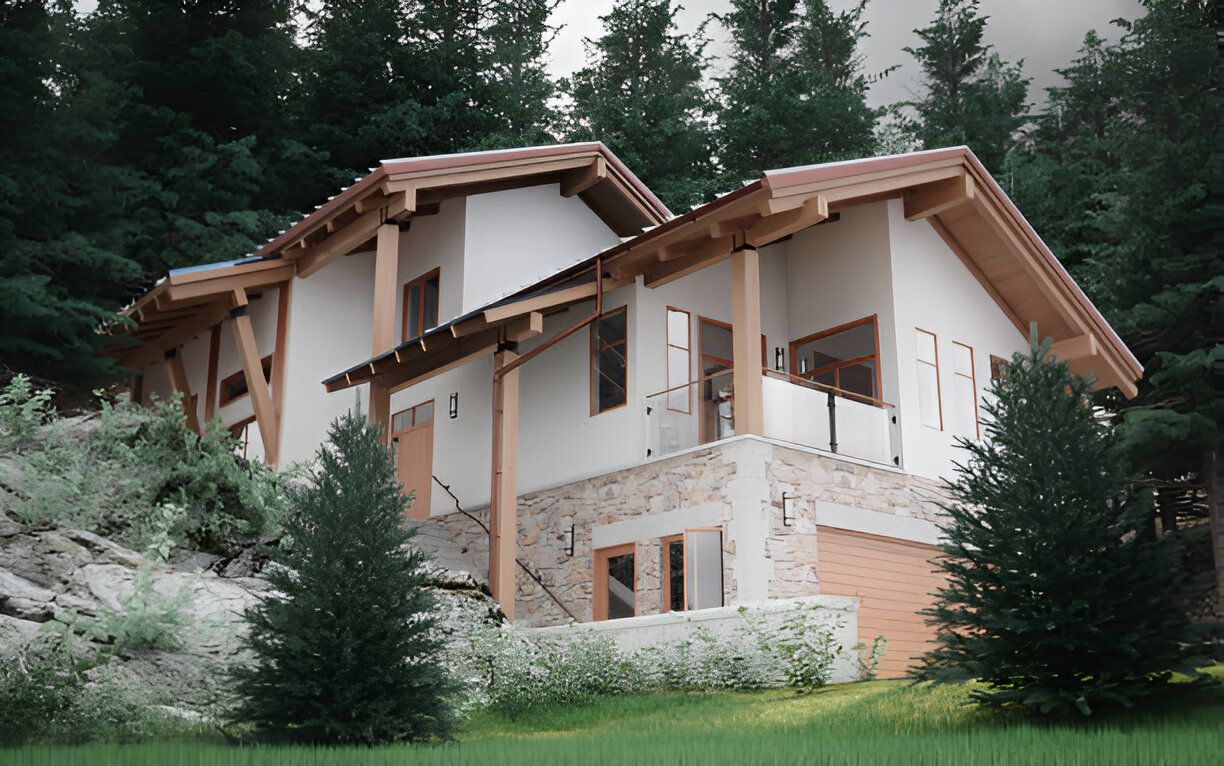
Cost of the Chandrashila Trek – Budget & Inclusions
The cost of the Chandrashila Trek can vary quite a bit depending on how you plan your trip (independent vs. tour package), your comfort level, and the duration of your stay. Here's a breakdown of the usual costs and what's typically part of them:
Overall Budget for the Chandrashila Trek
For a standard Chopta Chandrashila Trek, including the Tungnath Temple, a realistic budget usually ranges from INR 4,000 to INR 18,000 per person. This wide range accounts for different types of accommodation and whether you're handling everything yourself or booking a full package.
General Cost Tiers:
-
Budget-Friendly (INR 4,000 - 7,000 per person): This level often covers basic shared tent or homestay accommodation, simple vegetarian meals, and sometimes a local guide for the trek itself. Transport to Chopta might be an extra cost or arranged from a closer point like Rishikesh or Haridwar.
-
Mid-Range (INR 7,000 - 12,000 per person): At this level, you usually get better accommodation (like Swiss tents or basic cottages), more complete meal plans, transport from cities like Delhi, Dehradun, or Haridwar, and a trek guide. These often come as part of common Chopta tour packages.
-
Premium/Comfort (INR 12,000 - 18,000+ per person): This higher-end option might cover private transport from Delhi, more comfortable cottage or deluxe tent stays, specially arranged meals, and more personalized guide services.
Breakdown of Trek Costs:
1. Transportation
This is often the largest cost, especially if you're coming from far away like Delhi.
-
From Delhi to Chopta (Round Trip):
-
Shared Cab/Bus: If you use buses to Rishikesh/Haridwar/Rudraprayag and then shared taxis, this could cost roughly INR 1,500 - 3,000 per person.
-
Private Taxi: Hiring a private cab can cost INR 10,000 - 16,000 one way for the entire vehicle; this cost can be shared among passengers. A round trip might be INR 20,000 - 30,000.
-
Tour Packages: Many Chopta tour packages from Delhi often include AC transportation (like a Tempo Traveller) as part of their total price, usually adding INR 3,000 - 4,000 per person to the overall package cost.
-
-
Local Transport in Chopta: If your stay isn't right at the trek's starting point, a short local taxi ride might cost around INR 50-100 per person.
2. Accommodation
Stays in Chopta are usually in camps or basic guesthouses, providing a good blend of comfort and natural immersion.
-
Campsites (Swiss Tents): Expect to pay around INR 1,500 - 2,500 per person per night for Swiss tents on a shared basis (twin/triple/quad), often with dinner and breakfast.
-
Basic Guesthouses/Homestays: These can range from INR 800 - 1,500 per person per night for a simple room, sometimes with meals.
-
Eco-Stays/Cottages: These might be a bit higher, from INR 2,000 - 3,500 per person per night, offering more comfort and amenities.
-
Part of Packages: Most Chopta tour packages generally cover 2 nights of accommodation in camps or guesthouses.
3. Food
Food in Chopta is usually simple and vegetarian.
-
With Tour Packages: Most packages that include accommodation will provide meals, typically breakfast and dinner. A 3-day/2-night package might offer 5-6 meals.
-
If Traveling Independently:
-
Per Meal: A basic meal at a local eatery or camp kitchen might cost between INR 150 - 300 per person.
-
Total Food: For a 3-day trip, plan about INR 1,000 - 2,000 for food if you're buying it separately.
-
-
Extra Expenses: Always budget extra for personal snacks, bottled water, tea/coffee, etc.
4. Guide Fees
While the Tungnath-Chandrashila trail is well-marked, a local guide can make the experience better, especially in winter or if you want local information.
-
Local Guide (for the trek): If you hire a guide on your own, it typically costs around INR 1,000 - 2,000 per day for the entire group (not per person).
-
With Tour Packages: Most organized Chopta tour packages include the services of an experienced trek leader or local guide as part of their total cost.
5. Permits & Entry Fees
-
Forest Permits: The Chandrashila Trek goes through the Kedarnath Wildlife Sanctuary. There are usually small forest entry fees.
-
Cost: Around INR 150 - 300 per person for Indian nationals. This fee is often covered if you book a tour package. Foreign nationals usually pay higher fees.
-
-
Camping Fees: If you plan to camp on your own (not at a commercial campsite), the forest department might charge nominal camping fees.
6. Other Potential Costs
-
Personal Expenses: This covers things like snacks, personal shopping, extra drinks, toiletries, phone charging, etc. (Budget around INR 500 - 1,000+).
-
Trekking Gear Rental: If you don't own trekking shoes, warm jackets, or other specific gear (especially for winter), you might need to rent these.
-
Porter/Mule Charges: If you need help carrying your personal luggage on the trek, you can hire porters or mules. This will cost extra (e.g., INR 300-500 per day per bag). Most packages cover the main luggage transport but not your personal backpack.
-
GST: Many tour packages add 5% GST as a separate charge.
-
Emergency Costs: Any unexpected expenses due to medical emergencies, rescues, or road blockages (especially during monsoon or heavy snow) are usually not part of package prices and are the traveler's responsibility. Getting travel insurance is strongly suggested.
In summary, a basic self-planned trip could be done for around INR 4,000-5,000 (not counting travel from Delhi). However, a comfortable Chopta tour package from Delhi that includes transport, food, accommodation, and a guide generally falls in the INR 7,500 - 12,000 range per person for a 3-4 day trip. Always carefully check what is and isn't covered when you book any package.

Flora, Fauna & Forest Trails – Nature Along the Trek
The Chandrashila trek, including the detour to Deoria Tal, isn't just about the stunning mountain views; it's a journey through a rich natural world. The entire region is part of the Kedarnath Wildlife Sanctuary, one of the most diverse protected areas in the Himalayas. This means you're walking through a vibrant ecosystem teeming with unique plants and animals.
Flora: A Burst of Colors and Greenery
The forests along the Chandrashila trek change with altitude and season, offering diverse plant life.
-
Rhododendron Forests: This is a major highlight, especially in spring (March to May). The trail, particularly around Deoria Tal and the lower parts of the Chopta-Tungnath trek, is lined with dense rhododendron trees. When they bloom, usually from late February to mid-April, these forests burst into brilliant shades of red, pink, and sometimes white, creating a truly magical scene. The local name for rhododendron is "Buransh," and its flowers are even used to make a refreshing juice.
-
Oak, Pine, and Deodar Trees: The lower and mid-altitudes are dominated by thick forests of oak, pine, and deodar. These evergreen trees provide a lush green cover throughout the year, making the air crisp and clean.
-
Alpine Meadows (Bugyals): As you gain altitude, especially around Chopta, you'll encounter vast, rolling green meadows known as "Bugyals." In warmer months, these meadows are carpeted with a variety of wildflowers, herbs, and grasses.
-
Medicinal Plants: The region is also home to numerous medicinal herbs and rare plants, cherished by locals and botanists. You'll see different types of lichens growing on wood and rocks.
Fauna: A Wildlife Wonderland
Being part of a wildlife sanctuary, the area is a haven for various Himalayan animals, though spotting them requires patience and a bit of luck.
-
Musk Deer: The Kedarnath Wildlife Sanctuary was specifically created to protect the endangered Himalayan musk deer. While elusive and shy, there's always a chance of spotting them, especially in quieter areas.
-
Himalayan Thar & Goral: These agile mountain goats are often seen on rocky slopes.
-
Bears & Leopards: Himalayan Black Bears and the very rare Snow Leopard (especially in winter at higher altitudes) are present in the sanctuary, though sightings are extremely uncommon and usually only by very lucky trekkers or wildlife photographers.
-
Smaller Mammals: Keep an eye out for Himalayan pika, red fox, martens, and various species of squirrels.
Forest Trails & Birdwatching: A Birder's Paradise
The varied habitats of the Chopta region, from dense forests to high-altitude meadows, make it a paradise for birdwatchers. Over 240 species of birds have been identified here, making it an "Important Bird Area" (as recognized by BNHS and BirdLife International).
-
Himalayan Monal: This vibrant and colorful pheasant is the state bird of Uttarakhand and one of the most sought-after sightings. Its iridescent plumage makes it truly stunning.
-
Pheasants: Besides the Monal, you might spot other pheasants like the Kalij Pheasant and Cheer Pheasant.
-
High-Altitude Birds: Look for the Snow Partridge and Himalayan Griffon (a large vulture).
-
Forest Birds: The oak and rhododendron forests are alive with the calls of many species, including:
-
Thrushes: Long-billed Thrush, Mistle Thrush, Plain-backed Thrush.
-
Flycatchers: Verditer Flycatcher, Rufous-bellied Niltava.
-
Woodpeckers: Himalayan Woodpecker, Scaly-bellied Woodpecker.
-
Laughingthrushes: White-throated Laughingthrush, Chestnut-crowned Laughingthrush.
-
Other common sightings: Blue Whistling Thrush, Yellow-billed Blue Magpie, various Tits, Accentors, and Warblers.
-
Birdwatching Tips:
-
Best Time: March to November is generally good for birdwatching, with migratory birds returning in spring. Early mornings and late afternoons are prime times.
-
Gear: Carry binoculars and a bird identification guide.
-
Patience: Wildlife spotting requires quietness and patience.
Whether you're visiting Deoria Tal with its mirror-like reflections of Chaukhamba peak, trekking through the silent rhododendron forests to Tungnath, or ascending to Chandrashila, the natural beauty and diverse wildlife around every bend make the Chopta tour package an unforgettable experience for nature lovers.

Book Your Unforgettable Chopta Tour Package with TourMyHoliday!
Ready to experience the breathtaking beauty of the Himalayas and embark on the incredible Chandrashila Trek? Let TourMyHoliday craft the perfect journey for you. We specialize in creating seamless and memorable adventures, ensuring you get the most out of your Chopta tour package.
Whether you're looking for a thrilling Chopta tour package from Delhi with all transport included, comfortable accommodation, delicious meals, or expert guide services for your trek, we have options to suit every traveler and budget. Our packages are designed to take the hassle out of planning, allowing you to focus purely on the magic of the mountains.
Why choose TourMyHoliday for your Chopta adventure?
-
Tailored Experiences: From solo travelers to large groups, we can customize your itinerary to match your preferences for trek difficulty, comfort levels, and duration.
-
Expert Guide Services: Our experienced local guides know the trails intimately, ensuring your safety and enriching your trek with local insights and stories.
-
Hassle-Free Planning: We handle all the logistics – transportation, accommodation, meals, and permits – so you don't have to worry about a thing.
-
Stunning Views Guaranteed: We arrange stays that offer spectacular views, making your Himalayan experience truly unforgettable.
Don't just dream about the "Skywalk" at Chandrashila or the serene Tungnath Temple – make it a reality!
Contact TourMyHoliday Today to Book Your Chopta Tour Package!
-
Phone: +91-9990055699 (Monday - Saturday, 10:00 AM - 7:00 PM IST)
-
Email: info@tourmyholiday.com
-
Website: www.tourmyholiday.com (Visit our website to explore various Chopta tour packages and send us an inquiry!)
Call us now or visit our website to discuss your Chopta tour package and secure your spot on this incredible Himalayan journey. Let us guide you to the heart of Uttarakhand's hidden gem!
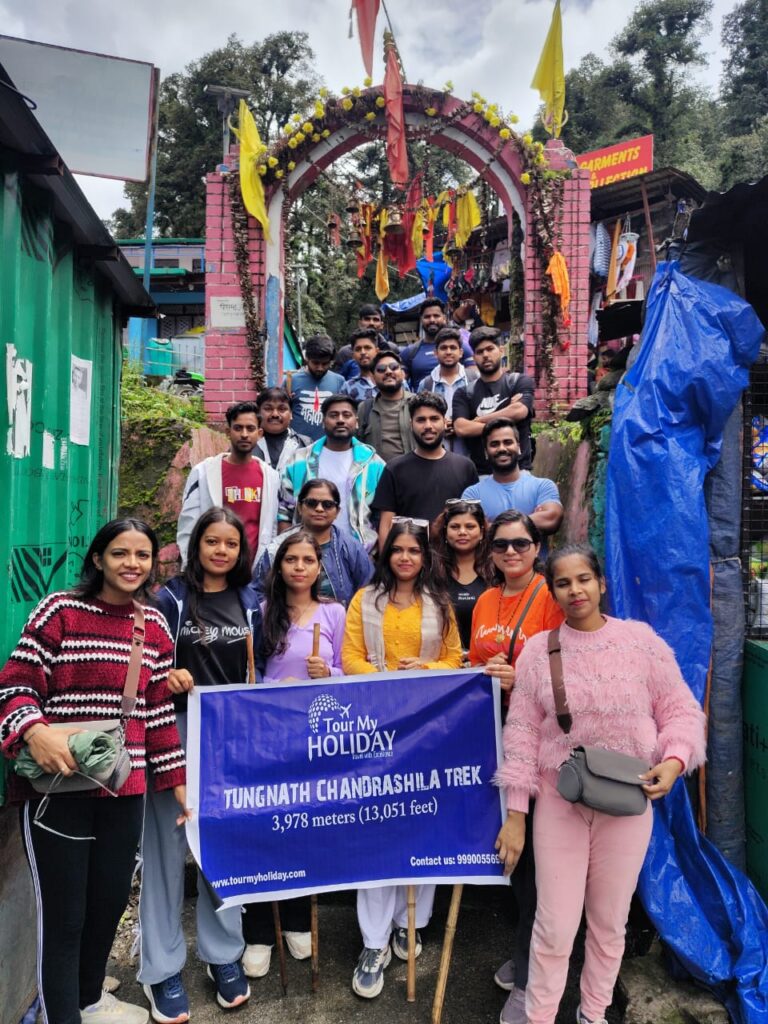
FAQs – Everything to Know About Chandrashila Trek from Chopta
1. What is included in a typical Chopta tour package?
Most Chopta tour packages include transportation, accommodation, meals, guided treks to Tungnath Temple and Chandrashila, and basic camping gear if required.
2. How difficult is the Chopta Tungnath trek?
It’s a moderate trek suitable for beginners with basic fitness. The trail is well-marked and scenic.
3. What is the best time to visit Chopta and Tungnath?
March to June and September to November are ideal. Snow lovers prefer December to February.
4. Is the Chandrashila trek suitable for beginners?
Yes, the Chopta Chandrashila trek is beginner-friendly and often chosen by first-time trekkers and families.
5. How long is the Chopta Tungnath trek?
The trek from Chopta to Tungnath is around 3.5 km one way, and an additional 1.5 km to Chandrashila summit.
6. What’s the altitude of Tungnath and Chandrashila?
Tungnath Temple sits at 3,680 meters, while Chandrashila summit is at 4,000 meters above sea level.
7. Are there Chopta tour packages from Delhi or Haridwar?
Yes, you can book a Chopta tour package from Delhi, Haridwar, Rishikesh, and Dehradun with flexible pricing options.
8. What is the average Chopta tour package price?
The price typically ranges from ₹5,500 to ₹9,000 per person, depending on the duration, group size, and inclusions.
9. Is Tungnath temple open throughout the year?
No, Tungnath Temple remains open from April/May to October/November and closes during winter due to heavy snowfall.
10. What kind of wildlife can I see in Chopta?
Chopta is rich in biodiversity—expect to see monals, musk deer, langurs, and a variety of Himalayan birds and flora.
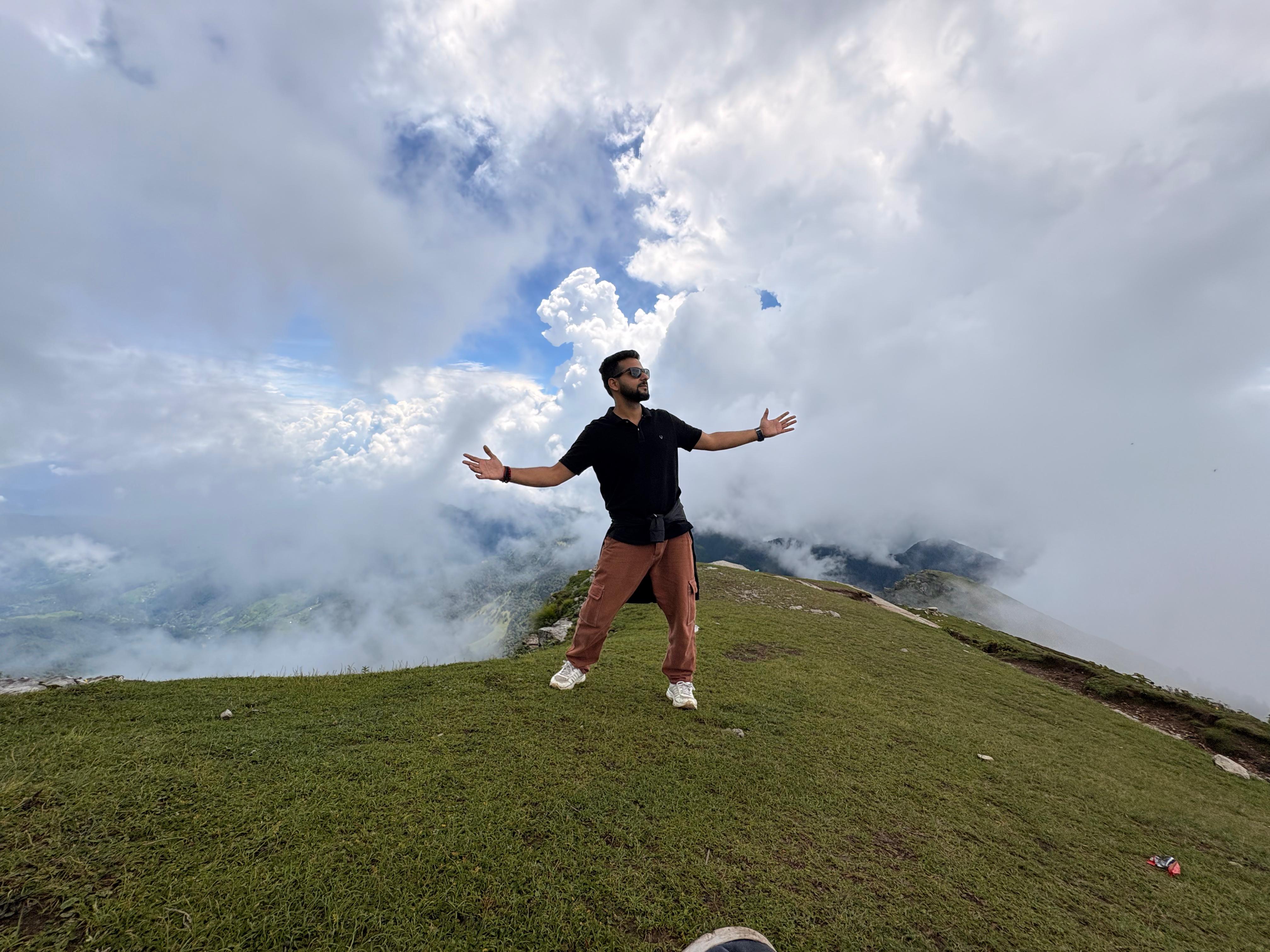

.jpg)
